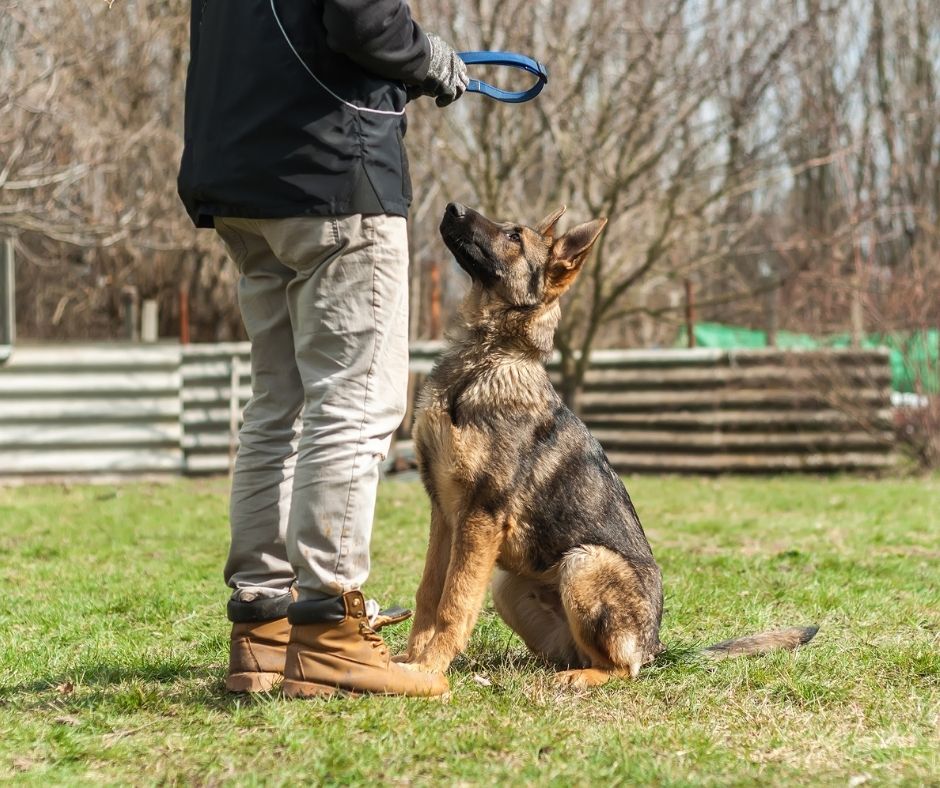In order to know how to train a German Shepherd Puppy, you are going to have to learn 7 basic dog training commands.
What are Dog Training Commands
Dog training commands are short words or simple hand signals dogs are conditioned into understanding as cues to do something. For example, if you want your dog to sit down you would simply ask them to do so by using the word “sit”. The word “sit” is the command word that you will have trained your dog to understand to mean you want them to sit down.
What Are The 7 Basic Commands
There are many command words you can teach your dog as they advance in their training. For the purpose of this guide, I am just going to focus on 7 basic commands that I think are the most important.
These commands will ensure your puppy’s safety and provide them with a good foundation to build on.
The 7 basic commands we are going to learn here are:
The “No” Command
The “Sit” Command
The “Down” Command
The “Come” Command
The “Stay” Command
The “Out” Command
Each command word you give your dog must have its own separate meaning.
Why Is It Important To Train A German Shepherd?
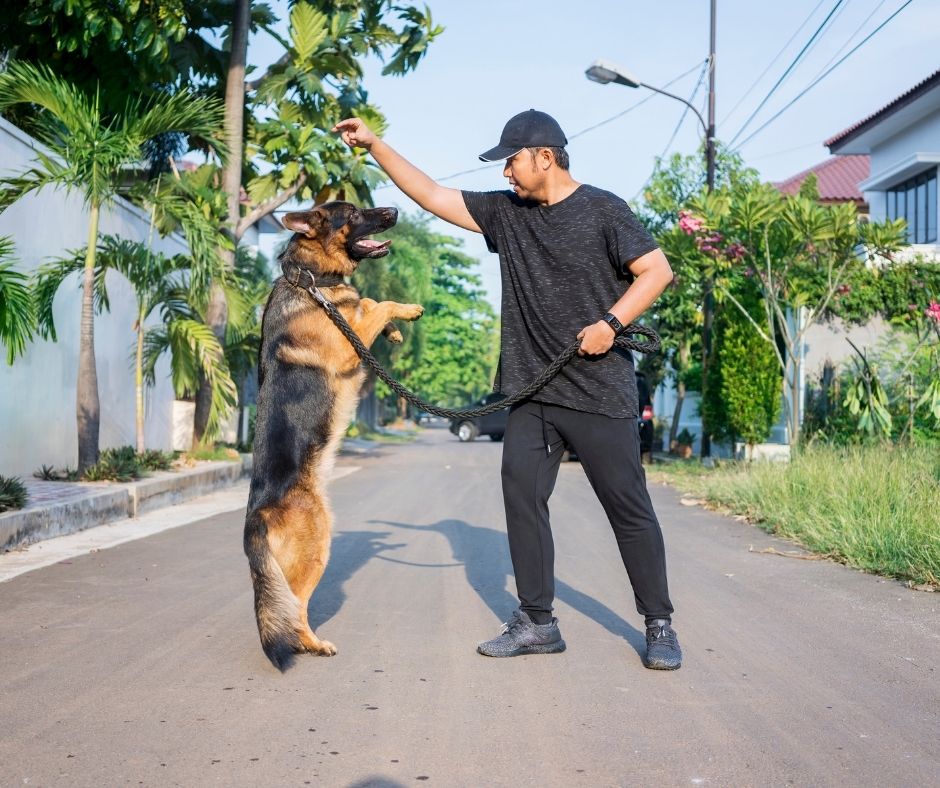
It is important to train any dog but this is especially so with big dogs such as a German Shepherd. Your puppy may well be a harmless cute bundle of fluff at the moment but he or she will soon be a big strong dog.
When standing on its hind legs an adult male German Shepherd can be almost as tall as you. They are also extremely powerful and quite capable of pulling up to 3 times their own body weight.
They are also very intelligent dogs so if they are not shown right from wrong they will use their K9 instincts to train themselves on how to behave. This means that it is very likely that they interpret things quite differently from what is acceptable behaviour to a human.
Are German Shepherds Easy To Train?
This is a question I am asked a lot and the simple answer is yes they are as long as you pay them well enough. I’m not joking here either they are extremely intelligent dogs and they will want to get something out of the deal.
The upside of their intelligence is that it won’t take them long to pick up what you are wanting them to do. The downside is that they also learn very quickly that they should be rewarded for their efforts.
What Is The Best Way To Train A German Shepherd
The best way to train a German Shepherd is using a positive training method. This simply means they are rewarded well and given plenty of praise for good behaviour.
There are 4 parts to this technique.
- Use your dog’s name to get their attention.
- Use a lure such as a tasty treat or toy to get them to focus on you.
- Name the command and show them how to do it.
- Praise them and give them the lure treat for doing it.
There will be times when your puppy makes mistakes or does something that is bad. A lot of the time it’s because they don’t know better or they are bored so have found something to do to entertain themselves.
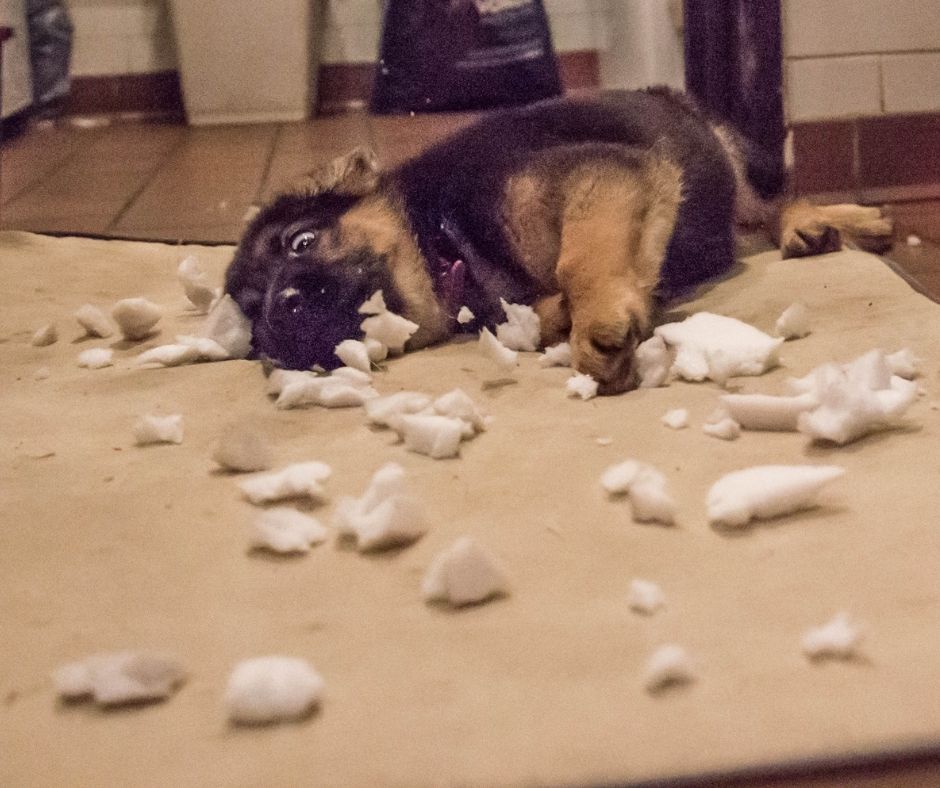
Neither of these situations is your dog’s fault. The fact that they don’t know right from wrong is because you have not taught them yet. The fact that they are bored is because you have not given them enough to do to stimulate their intelligent brains.
No matter how upset or frustrated you may feel it is pointless yelling at your dog. They simply won’t know why you are acting that way. At best they will think you are alert barking at something they don’t know exists yet and join in. At worst you will frighten them which can lead to a whole load of anxiety problems later on.
You should also never hit your dog either. Even a gentle tap on the nose or paw may seem mild to you but it is a bad signal. They will just see it as aggression and never understand why the person they love and trust has suddenly become violent towards them.
The correct and only way to discipline a German Shepherd is to divert the bad behaviour into something positive. You then reward the positive.
What Equipment Do I Need To Train A German Shepherd?
You don’t need to spend a huge amount of money training your German Shepherd puppy. The basic equipment you will need to carry out everything in this guide is:
- A strong comfortable Leash – no more than 6 feet long
- A strong lightweight longer leash – about 15 feet long for recall
- A training collar
- Some treats – these don’t have to be food-related. If toys are more precious to your dog than a food treat then using a toy or ball as a treat will work very well too.
What Is The Best Age To Train A German Shepherd?
The best age to train a German Shepherd is between 8 weeks and 9 months of age. This is the age when they are developing the fastest and their little minds are like information sponges. They are so eager to investigate and experience everything the world has to offer.
Having said that it is never too late to train a German Shepherd. You have heard of the saying you can’t teach an old dog new tricks well it is perfectly achievable with a German Shepherd.
You may find that an older dog may have some issues or bad habits that need a little more specialist attention. They are also a little bit more worldly-wise so will probably be more stubborn but they will still respond to positive training. You may just have to negotiate a bit more where the treat value is concerned.
Make Training Fun
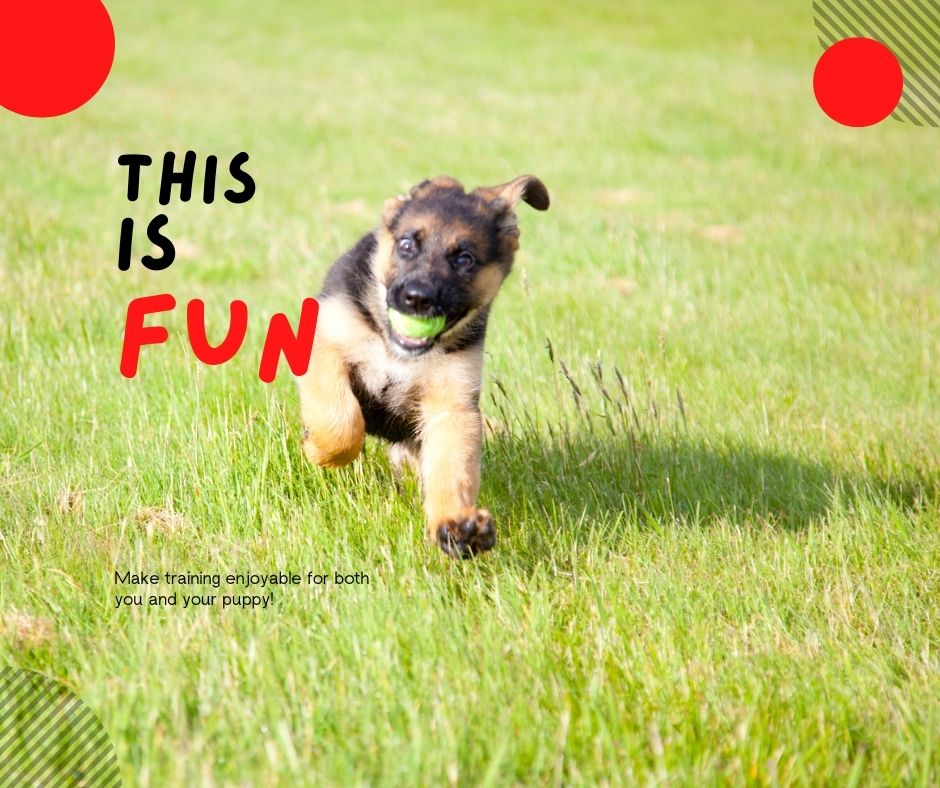
Training should be an enjoyable experience for both you and your dog and dogs of all ages love to play games. We all know the lessons at school we used to love and those that were so boring we could have fallen asleep. It’s no different for a dog so if you can make the training exciting you are going to get a much better response from them no matter what age they are.
Can You Train A German Shepherd At Home?
The best place to train a German Shepherd is wherever it is safe and there are unlikely to be any distractions.
Training a German Shepherd at home is probably the best place to start. Choose a time of day when your puppy is most alert and make sure it is at least 2 hours after he or she has eaten. You need them to give you their best attention for as long as possible.
Once your puppy has a few commands under its belt that you have taught at home then you can mix the training venues up.
Try taking them to the park or beach and testing the commands there too. It is much more difficult for your puppy to concentrate when there are other exciting things going off so be prepared for mistakes to happen. Be patient and don’t give in they will get there in the end.
How Long Should Each Training Session Last?
Puppies have a much shorter attention span than adult German Shepherd Dogs. At first, you may find that they are only able to cope with a training session for a few minutes at a time. You should just concentrate on one command at a time and be consistent.
How will I know If My Dog Has Mastered The Command?

Many trainers will tell you that 10 is the magic number. If your puppy carries out the command 10 times in a row then it is usually safe to assume that they understand what you are asking them to do.
So What Are The 7 Basic Dog Training Commands?
| Command | Meaning and When To Use It | Spoken Voice |
|---|---|---|
| No | Use this command to tell your dog that their behaviour is not acceptable or to stop them from doing something. | Firm and sharp but not shouted |
| Sit | This is the command used when you want your dog to sit down. | Firm and calm |
| Down | This is the command used when you want your dog to lie down. | Firm and calm |
| Come | Use this command if you want your dog to come to you. | Happy and excited |
| Heel | This is the command used to tell your dog not to pull and that they should walk at your side at your pace on a loose leash. | Firm and calm |
| Out | Used to tell your dog to drop something it has in it’s mouth. You can also use other words like “drop it” if you prefer. Just make sure to choose only one for the task and stick to it. | Firm and stern but not shouted |
| Stay | Your dog stops still and waits for you to tell it to move again. This is a harder command to teach as your dog will naturally want to follow you. You need to master the other commands first before you introduce this. | Firm and calm |
How to Teach A German Shepherd The “No” Command
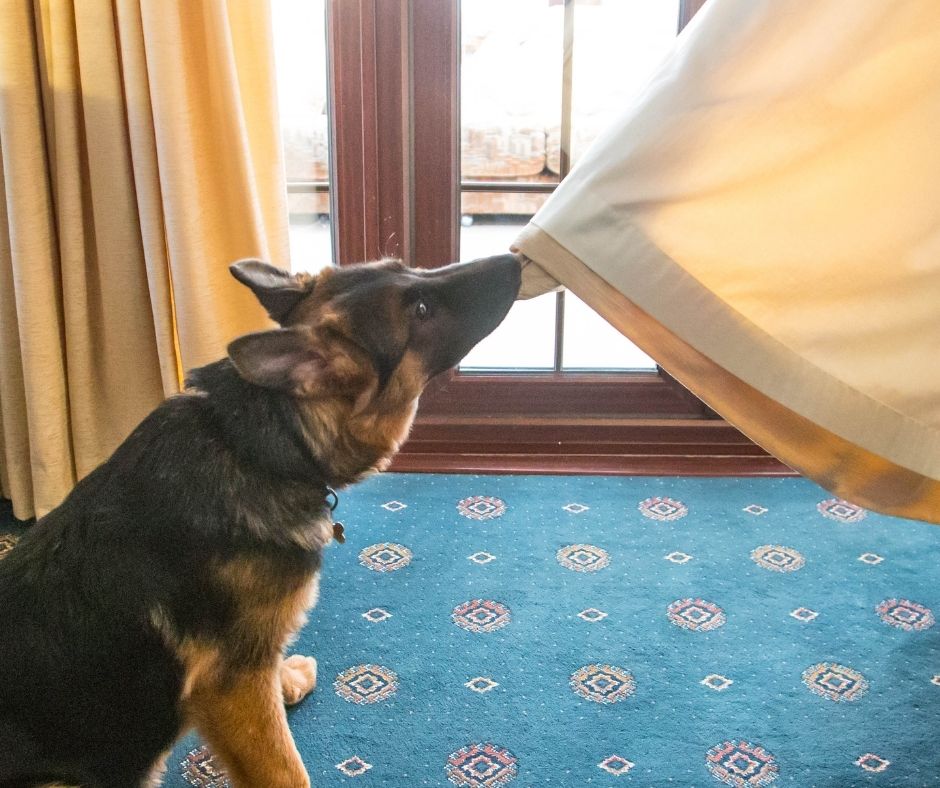
This is probably the first command word you will use with your puppy and the one that will be used most often whilst they get used to their new environment. It is also a very important one for them to learn and can be a life saver.
It is a discipline command that is used to halt unwanted behaviour. The aim is to get your dog to instantly stop what they are doing and wait for further direction.
When to use it
Whenever your puppy is doing something he or she shouldn’t.
An example might be that they are caught chewing a TV remote, some shoes or even worse the furniture.
To stop your puppy from doing something they are thinking about doing.
An example might be wanting to eat something you have dropped on the floor. Another would be if they are thinking about chasing that bird that has landed a few feet away from them.
How to use it
All you need to do is stop them from doing the unwanted behaviour with a simple “no” said firmly and sharply but not shouted. If they are on a leash at the time give a short sharp pull on it at the same time as saying the word.
Remove the item they shouldn’t have from them and replace it with one of their own toys.
Or remove your dog from the situation if the problem is on a bigger scale and ask them to do something else that they can do for example sit.
Now praise the good behaviour with lots of fuss, encouragement and a treat.
Your dog will soon get the message to learn what behaviour gets rewarded and what doesn’t.
How To Teach A German Shepherd To Sit
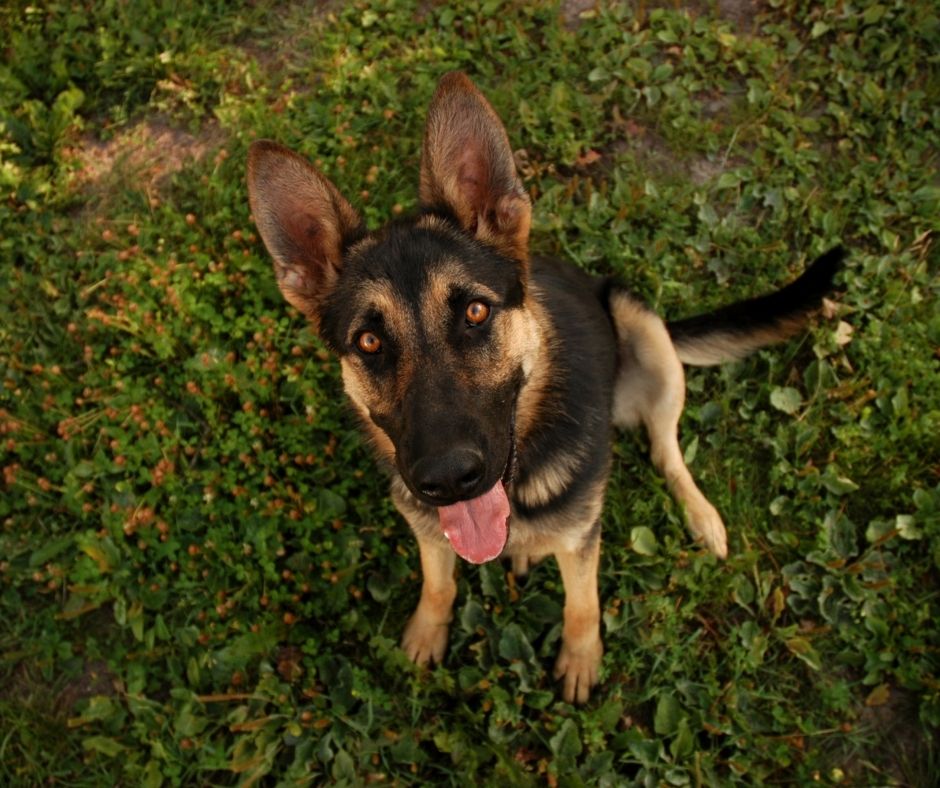
The sit command is a good place to start with your puppy and is relatively easy to teach too. Once your puppy has mastered the sit command it is easier to move on to other commands such as down or stay.
When to use it
Asking your dog to sit helps them focus on you so good times to use it are times when you are looking for that focus.
An example could be at the start of a training session when their energy is at its highest. Another good one would be before you cross a busy road when you will want their attention to be on you rather than what’s on the other side. It can also help end a training session on a positive note.
How to use it
Use your dog’s name to call them to you. Get them to face you and hold a bite-size tasty treat in your hand a couple of inches above your dog’s nose so that they can see and smell it.
Now move the same hand up and over your dog’s head. They will instinctively follow the smell of the treat which will cause them to naturally sit. As soon as your dog’s bottom touches the floor name the action by saying the word “sit”.
Now praise them with your praise word ie good boy or good girl and give them the treat as a reward.
How To Teach A German Shepherd To Lie Down
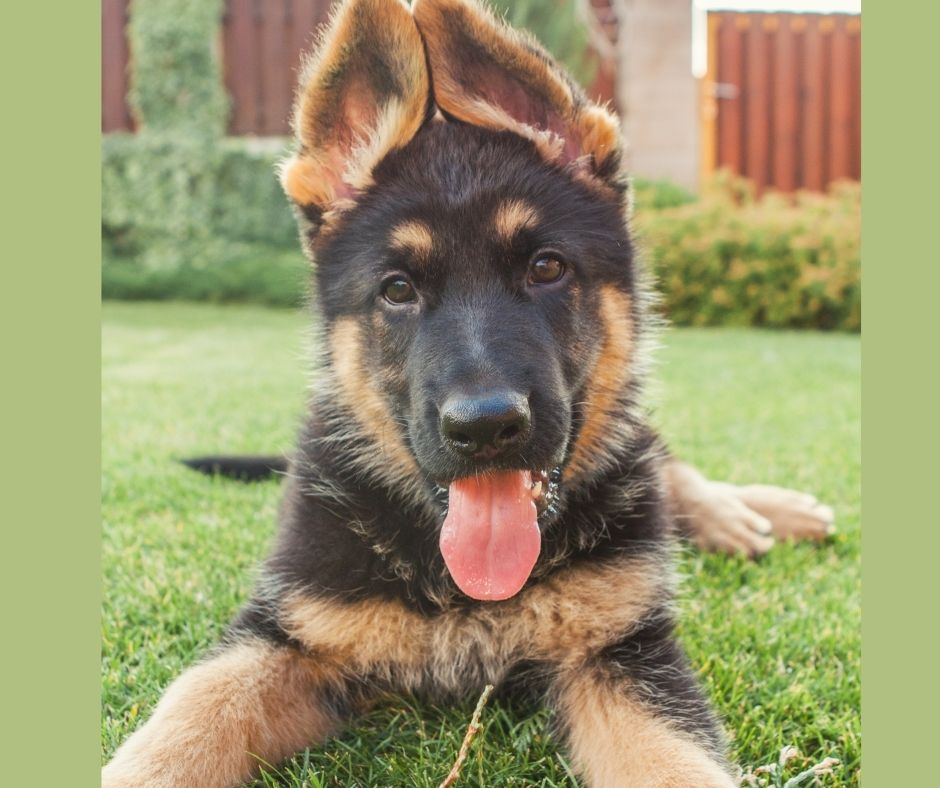
This command is useful if you need your dog to settle in one place for a while.
When to use it
You are likely to want to use it if you are visiting a public place where you intend to stay for a while. For example a dog-friendly bar, a day at the beach or even just stopping for a break at a park bench.
How to use it
You can start this with your dog either sitting or standing. I would go with whichever position they put themselves in naturally when they come to you rather than asking them to sit first as it could cost you a treat.
Use your dog’s name to call them to you.
Get them to face you and hold the treat in your hand. This time a couple of inches in front of your dog’s nose but again close enough for them to be able to see and smell it.
Now move the same hand in a downward motion to the floor between your dogs’ paws. They will follow the smell of the treat but at first, may just bow rather than lie down completely. If so you will need to lengthen the movement from in between their front paws into an L shape. You do this by continuing the move across the floor until your dog has to lie down completely to get the treat.
Never try to push them down just keep repeating it until they get it right. As soon as their whole body touches the floor name the action by saying the word “down”.
Then praise them and give the treat as their reward.
How To Teach A German Shepherd To Stay
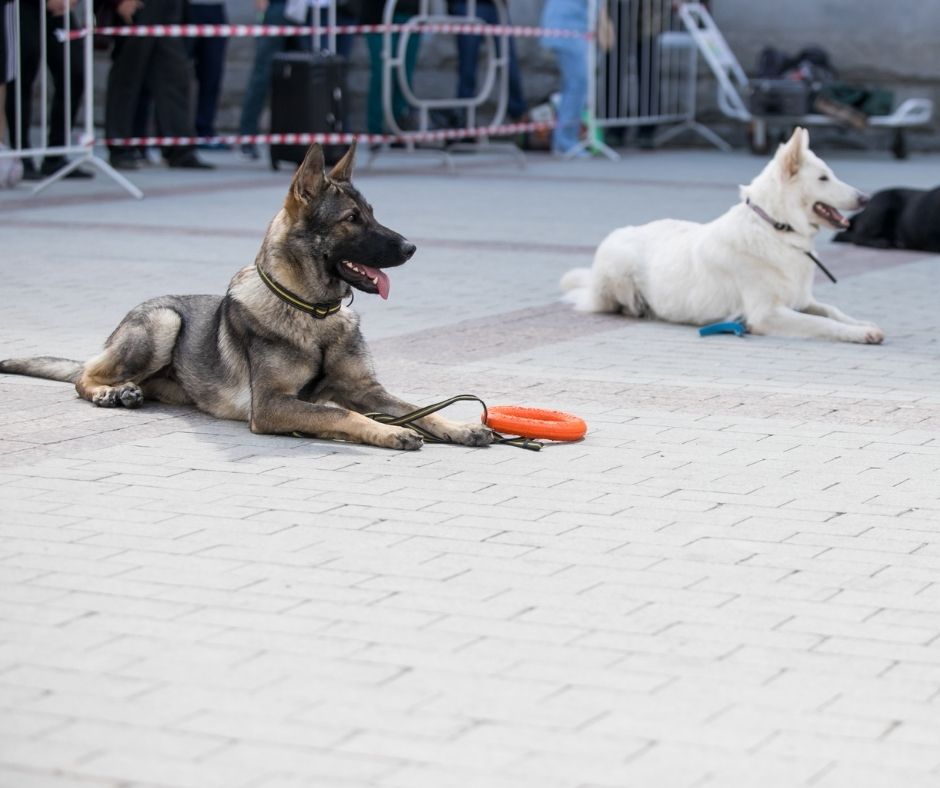
This is where your dog stops still and waits for you to tell it to move again.
When to use it
This can be combined with the down command to get your dog to stay lying down. A more advanced version of this would be to get them to stay put while you walk away from them. The latter takes quite a bit longer as your dog will instinctively want to follow you. Teaching your dog this command will also give then a good foundation for more complex training later on.
How to use it
Your dog will need to know the sit command before you teach him this and it is also best done when they are less energetic for example after a walk.
Use your dog’s name to call them to you and ask them to sit.
This time don’t let your dog see the treat.
When your dog is seated start to move away from them slowly. You are only looking for a few steps to start with then name the fact that they are not moving with the command “stay”. If they get up or start to follow you just repeat it. Patience and persistence will be needed here but if you stick with it they will understand and you can begin to move further and further away.
Each time your dog stays in position and allowed you to step away from them then praise and reward them.
How to Teach A German Shepherd To Come To You
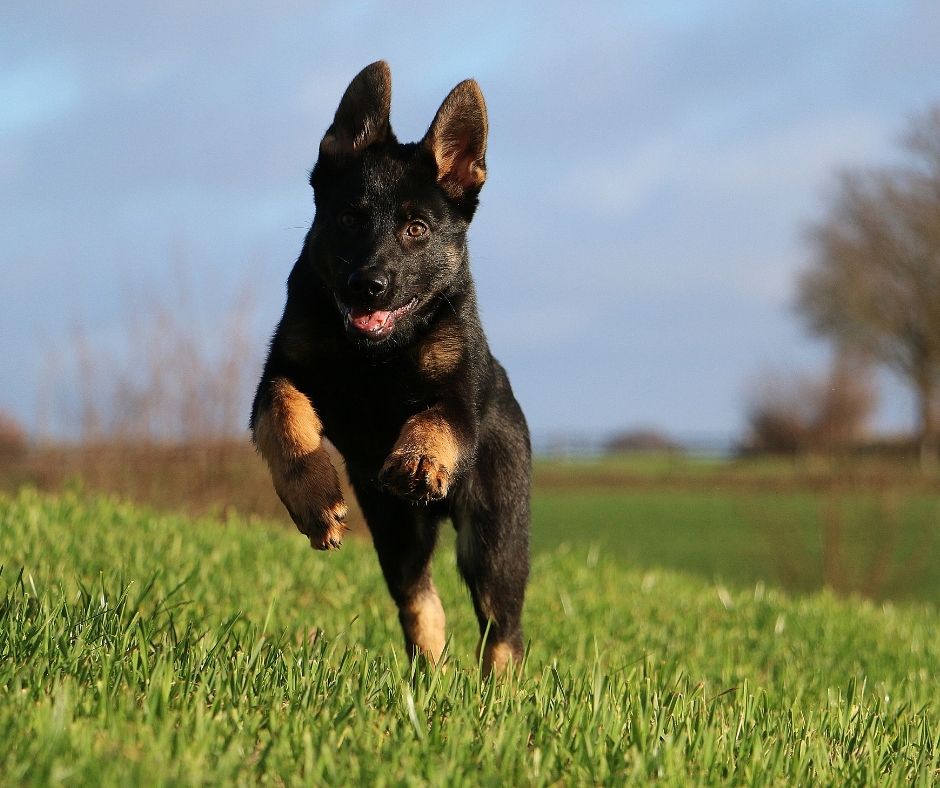
This is the recall command and is one that could well help keep your dog out of danger. No one wants a dog that refuses to come back to you. Not only is it stressful it can also be dangerous for your dog to be loose and out of control from you in this way. So this command is an important one that should be taught as early on in your dog’s life as possible.
When to use it
All the time if you are in an area where you are allowed to walk your dog off-leash. It is important that they know to come to you upon command and you should not let your dog off-leash until he has reliably mastered the recall command. This will ensure you are in control of their safety but it also means they are going to be less intimidating to other people using the same public places.
How to use it
Your dog needs to associate you calling its name with the excitement of really happy times and wonderful treats. It does take some time to teach a reliable recall and the reward value also needs to be really high. The times you are going to be needing to use this are probably going to be times when your dog has seen something really exciting that it wants to go to. This could be another dog in the distance or something he wants to chase.
When dogs are in this excitable state it is difficult for them to focus on you. It’s important that you don’t show panic in your voice when calling them. Keep everything calm and sound exciting.
You need to use their name followed by the command word “come”. To practice this you need to use every pleasant opportunity you can to do this.
For example, calling them at dinner time or when you are taking them for a walk. Never use it when calling them to have their nails trimmed or anything else that they would perceive as unpleasant.
You will need to use a high-value treat for effective recall. Remember you are up against a fun chase game or a potential exciting playmate in the distance. German Shepherd dogs will balance the rewards and pick the one that is most favourable to them. If your reward is not good enough it won’t be picked its as simple as that.
Make the calling of their name sound really happy and exciting.
When they reach you give them lots and lots of fuss and the high-value treat.
How To Teach A German Shepherd To Not Pull On The Leash
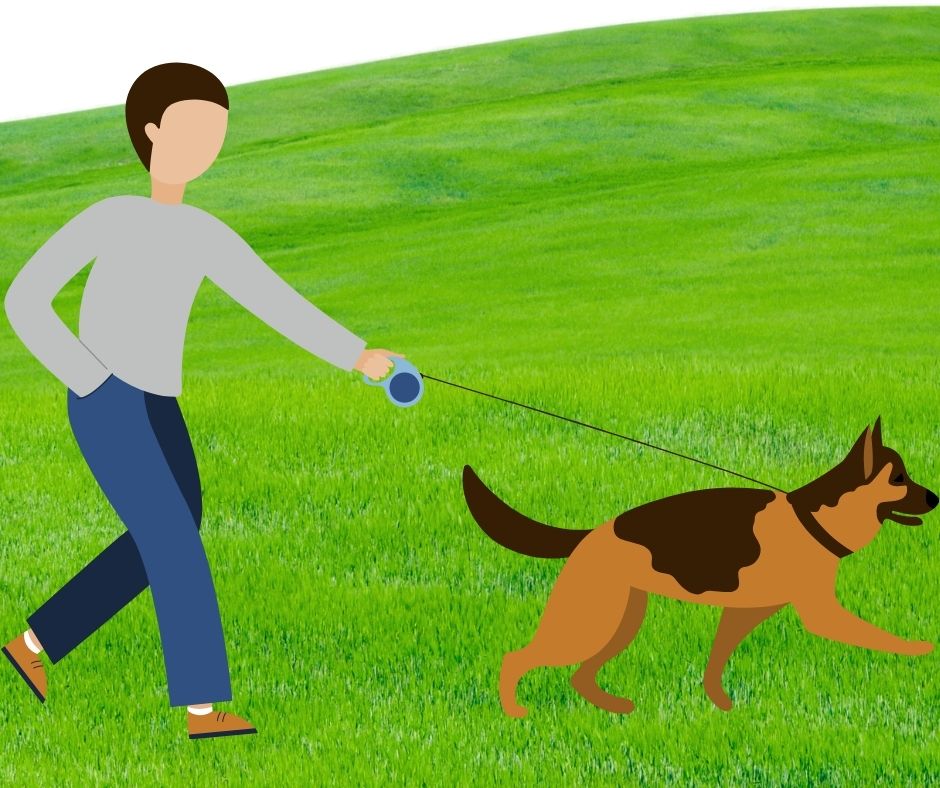
I speak from experience here as my male German Shepherd used to pull a lot. We didn’t really have a problem with our female and he was fine as a puppy so it’s not something we spent any time on training him to do. Roll on 18 months and he was so strong only my husband was able to handle him. This made it unpleasant not just for whoever was handling him but also for Cody as he was quite literally choking himself on every walk he went on.
When to use it
My advice is to start using this as soon as you start your leash training with your puppy. Don’t make my mistake it became a habit for Cody and was quite difficult for us to correct later on particularly at the start of a walk.
How to use it
You should use this all the time whilst your dog is on the leash even if they don’t seem to be pulling yet. The aim is to show your dog the correct position to walk in when on the leash. They need to understand that this is in line with your knee. If they do this and also learn to walk at your pace then the leash should be loose at all times.
Call your dog to you and attach the leash.
Have a pocket full of tasty treats.
Walk at a steady pace trying to keep your dog in line with your knee. Use short sharp tugs at the lead to pull your dog back into position accompanied by the command word “heel”.
Every time your dog obeys the command and walks in the correct position praise and reward him.
How To Teach A German Shepherd To Drop or Leave Something
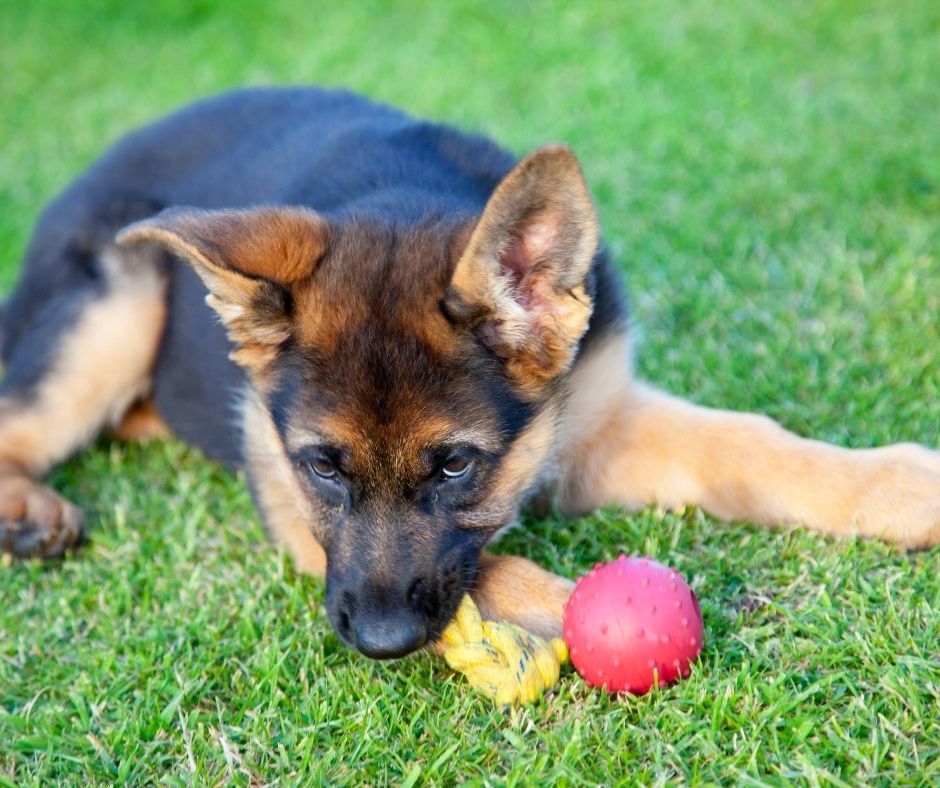
I use the word “out” for this command but you can use other words such as “drop it” or “leave”. The command will teach your dog to instantly drop something it has in its mouth.
When to use it
The times you will want to use this is for your dog’s safety. For example, if he picks something up he should not but you can also use it for fun games such as catching a ball or tidying away. Using this command your dog will give you the ball to throw for them and you will be able to get them to tidy their toys away too.
How to use it
In order to get this to work the lure or treat you use will have to be of a higher value than the one you are asking your dog to give up. If you don’t then he is likely to realise it’s not a good deal and refuse to do the trade with you.
Start with a low-value toy. Pick it up and start playing with it then ask your dog over to join in and give him the toy.
When they have the toy in their mouth let them see the tasty high value treat.
Then ask them to drop the toy by saying the word “out”. It may take a few attempts but persevere.
As soon as they drop the toy give them the treat.
Keep repeating this and increasing the value of the toy and the treat each time.
Why Is My German Shepherd Not Learning Anything?
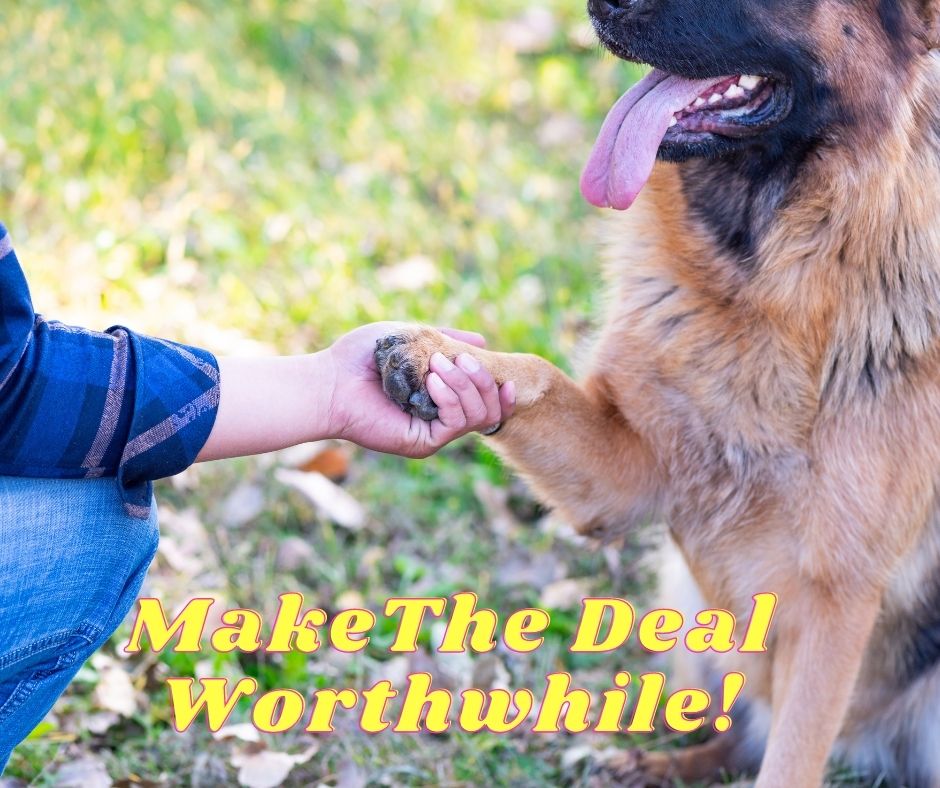
In order to train a German Shepherd do not underestimate their intelligence. In theory, the more intelligent a dog is the easier they are to train. You also need to weigh this up with the fact that intelligent dogs have minds of their own. It doesn’t take them long to realise that they are not getting a good deal either.
You will know when this happens as they will either go into actor mode and pretend they haven’t got a clue what you are talking about. Or they will give you their stubborn stance and arrogantly make it clear that they are not going to do it.
This may happen if the training is boring or the value of the reward is not worth it. As it is very unlikely that your dog is not learning anything you will need to look at your situation. Training needs to be fun for both you and your dog so try introducing some games and making it more exciting.
Also, look at what you are offering in return. As a rule of thumb, the value of the award needs to be higher than what you are asking them to give up. It has to be worth the effort you are asking them to put in.
Final Thoughts On How To Train A German Shepherd Puppy
Patience, persistence and consistency are the key things you need to take away from this. Some things your puppy will grasp straight away others take a little bit more time for them to understand what it is you want. They will get there in the end and when they do you will have got yourself a fantastic dog that will be a pleasure to have around.
So these are the 7 basic commands that will give your pup the best start in life. It doesn’t have to stop here though German Shepherd dogs will crave brain stimulation so the more you can do with them the better. There are so many advanced commands and brain training games you can start to introduce once your dog has mastered these.
I hope you found this information useful. Please feel free to ask any questions or let me know how you are getting on with your training in the comments below.
